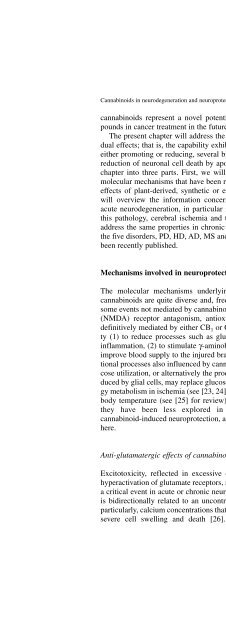3. Umbruch 4.4..2005 - Online Pot
3. Umbruch 4.4..2005 - Online Pot
3. Umbruch 4.4..2005 - Online Pot
Create successful ePaper yourself
Turn your PDF publications into a flip-book with our unique Google optimized e-Paper software.
Cannabinoids in neurodegeneration and neuroprotection 81<br />
cannabinoids represent a novel potential utility of cannabinoid-based compounds<br />
in cancer treatment in the future [1, 3].<br />
The present chapter will address the evidence concerning the first of these<br />
dual effects; that is, the capability exhibited by cannabinoids to influence, by<br />
either promoting or reducing, several biochemical mechanisms leading to the<br />
reduction of neuronal cell death by apoptosis or necrosis. We will divide the<br />
chapter into three parts. First, we will summarize the different cellular and<br />
molecular mechanisms that have been reported to underly the neuroprotective<br />
effects of plant-derived, synthetic or endogenous cannabinoids. Second, we<br />
will overview the information concerning these neuroprotective effects in<br />
acute neurodegeneration, in particular in the two major accidental causes of<br />
this pathology, cerebral ischemia and traumatic brain injury. Third, we will<br />
address the same properties in chronic neurodegeneration, with emphasis on<br />
the five disorders, PD, HD, AD, MS and ALS, where relevant information has<br />
been recently published.<br />
Mechanisms involved in neuroprotection by cannabinoids<br />
The molecular mechanisms underlying the neuroprotectant properties of<br />
cannabinoids are quite diverse and, frequently, complementary. They include<br />
some events not mediated by cannabinoid receptors [i.e. N-methyl-D-aspartate<br />
(NMDA) receptor antagonism, antioxidant properties] and others that are<br />
definitively mediated by either CB 1 or CB 2 receptors including their capability<br />
(1) to reduce processes such as glutamate release, calcium influx and/or<br />
inflammation, (2) to stimulate γ-aminobutyric acid (GABA) action and (3) to<br />
improve blood supply to the injured brain (for review, see [4–6]). Other additional<br />
processes also influenced by cannabinoids, such as improvement of glucose<br />
utilization, or alternatively the production of ketone bodies – which, produced<br />
by glial cells, may replace glucose as the major source of neuronal energy<br />
metabolism in ischemia (see [23, 24] for review) – or the lowering effect on<br />
body temperature (see [25] for review), might be also considered. However,<br />
they have been less explored in relation to their involvement in<br />
cannabinoid-induced neuroprotection, and therefore they will not be addressed<br />
here.<br />
Anti-glutamatergic effects of cannabinoids<br />
Excitotoxicity, reflected in excessive extracellular levels of glutamate and<br />
hyperactivation of glutamate receptors, mainly the NMDA receptor subtype, is<br />
a critical event in acute or chronic neurodegeneration (see [26] for review). It<br />
is bidirectionally related to an uncontrolled shift in sodium, potassium and,<br />
particularly, calcium concentrations that disrupt ionic homeostasis and leads to<br />
severe cell swelling and death [26]. Cannabinoid agonists are certainly







